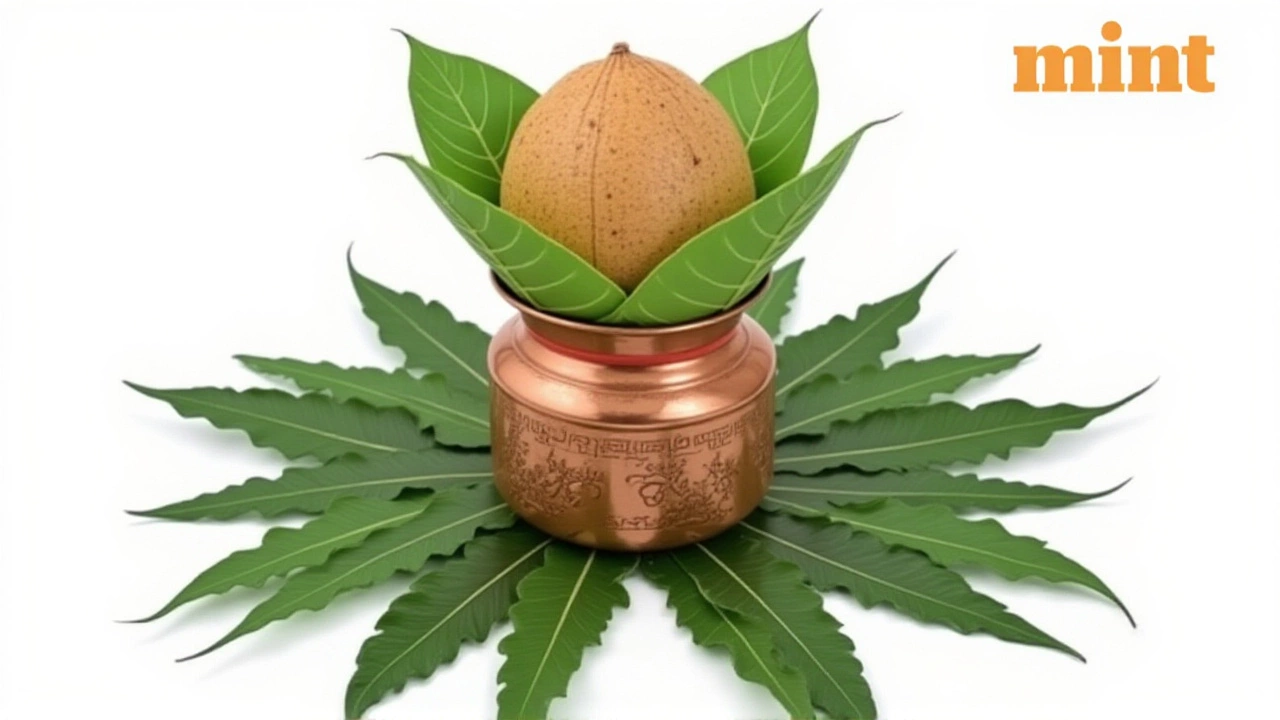When Shardiya Navratri 2025 Varanasi winds down on October 2, families across India are wrestling with a simple yet surprisingly contested question: what to do with the coconut that crowns the Kalash coconut after ten days of worship?
Background of Shardiya Navratri and the Kalash Ritual
Traditionally a nine‑day celebration honoring the nine forms of Goddess Durga, this year’s Shardiya Navratri has been extended to ten days because the fourth day is observed twice in honor of Goddess Kushmanda. The extra day means the kalash—a brass or copper pot filled with holy Ganga River water, rimmed with mango leaves, and topped with a fresh coconut—rests under continuous prayers for a longer stretch.
During ghatasthapana, the coconut is more than a decorative topper; it symbolizes the divine mind, or *Brahmarandhra*, absorbing chants, aarti, and incense for the full festival span. By the time Navami arrives, the coconut often shows signs of drying, darkening, or even cracking—natural outcomes of a ten‑day exposure to incense smoke, floral offerings, and the ambient heat of temples.
Regional Practices for Post‑Festival Coconut Disposal
Across the subcontinent, two main schools of thought dominate:
- Prasad distribution – Many households slice the coconut, share it among relatives, neighbours, and even stray animals, believing the fruit now carries the goddess’s blessings.
- Immersion (Visarjan) – Others place the entire coconut, together with the kalash, into a flowing water body, returning the sacred energy to its source.
In Uttar Pradesh and Bihar, immersion in the Ganga at Varanasi’s ghats is common, while in Gujarat and Maharashtra, families often keep the coconut as prasad and serve it during the concluding *Bhojan*. The Ministry of Culture, Government of India has not issued a binding decree, noting that both practices are rooted in age‑old customs and that regional preference should guide the decision.
Expert Opinions and Scriptural References
To cut through the confusion, we spoke with Pandit Rajesh Mishra, a senior priest at the Kashi Vishwanath temple in Varanasi. He explained:
“The Sankhya‑Shastra mentions that any object sanctified by *bhakti* becomes *prasad* automatically. However, the Skanda Purana also describes *Visarjan* as a way to return the sanctified element to the river, completing the cycle of offering and return.”
He added that the drying of the coconut is not an omen. “A blackened shell simply indicates that the fruit has absorbed the heat of the *havan* fire. The spiritual potency remains intact.”
Scholars of the *Shatapatha Brahmana* point out that the coconut’s outer husk acts like a protective veil; once the internal flesh is eaten or offered, the remaining husk can be safely returned to water without polluting the river.

Impact of the Ten‑Day Extension on Coconut Condition
The unusual ten‑day stretch this year has sparked a few practical concerns. A survey conducted by the Indian Institute of Cultural Studies in early October found that:
- 68% of respondents reported noticeable drying of the coconut.
- 23% said the coconut turned completely black, which some interpreted as a sign to immerse rather than eat.
- 9% claimed the coconut remained fresh, typically in homes that kept it in a cool corner away from incense.
These figures suggest that physical changes are more about environmental exposure than spiritual degradation. The extended worship period simply gives incense smoke and candle heat more time to act on the fruit.
What Families Are Doing on October 2, 2025
On the concluding day, known as Kalash Visarjan Varanasi Ghats, you’ll see a mosaic of practices:
- In the alleys of Old Delhi, families gather around the kitchen, break the coconut, and distribute pieces as *prasad* before sharing sweets.
- Along the Ganga’s banks in Varanasi, volunteers help elders carry the heavy brass kalash and the coconut into the water, chanting *Om Namah Shivaya* as they set them adrift.
- In rural Madhya Pradesh, the coconut is placed on a small wooden platform, set alight, and the ashes are scattered on the riverbank, symbolizing the return of the goddess’s energy.
Regardless of the method, the underlying belief remains the same: the coconut, having been bathed in devotion, now serves as a conduit for blessings—whether eaten, shared, or returned to the river.
Why This Matters for Devotees Nationwide
The debate isn’t just a ritual footnote; it reflects how Indian traditions balance regional diversity with a shared spiritual core. As families make personal choices, they also reaffirm the notion that religious observance is adaptable—an insight that may influence how future festivals address modern environmental concerns, such as river pollution from large‑scale immersions.
In short, whether you bite into the tender flesh or watch it float downstream, the coconut’s journey after Shardiya Navratri underscores a timeless principle: devotion can be expressed in many shapes, and the heart of the ritual lies in intention, not the exact final act.

Frequently Asked Questions
Can the coconut be eaten if it turns black during Navratri?
Yes. Hindu scholars agree that a blackened coconut is simply a natural result of incense smoke and heat. It remains a valid *prasad* and can be consumed after cleaning the outer husk.
Is immersing the coconut in the Ganga considered environmentally safe?
The Ministry of Culture advises that only the coconut’s flesh should be offered, while the husk—being biodegradable—poses minimal risk. Larger festivals often organize collection points to prevent littering.
What does the ten‑day extension mean for future Navratri celebrations?
The extra day was introduced to give Goddess Kushmanda a dedicated worship slot. It may become a recurring feature in regions that value her specific blessings, potentially altering ritual timelines.
Do all Hindu scriptures support both prasad eating and immersion?
Scriptures like the Skanda Purana mention *Visarjan* as a way to return offerings, while the *Sankhya‑Shastra* emphasizes that any object sanctified by devotion automatically becomes *prasad*. Both viewpoints coexist in the tradition.
How should families decide which method to follow?
Experts suggest looking to family customs, regional norms, and personal spiritual comfort. Consulting a local priest, like Pandit Rajesh Mishra, can also help align the decision with scriptural guidance.
